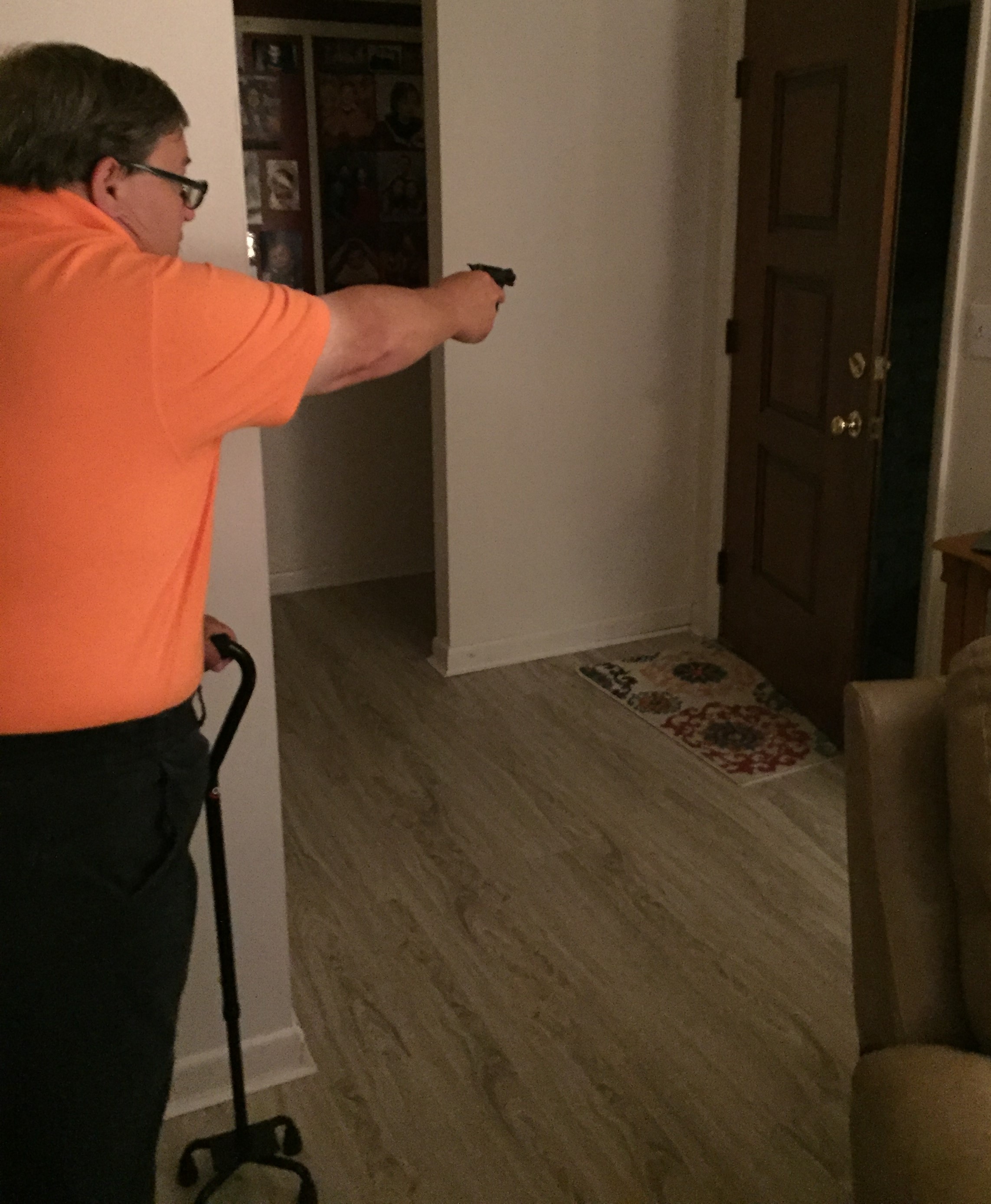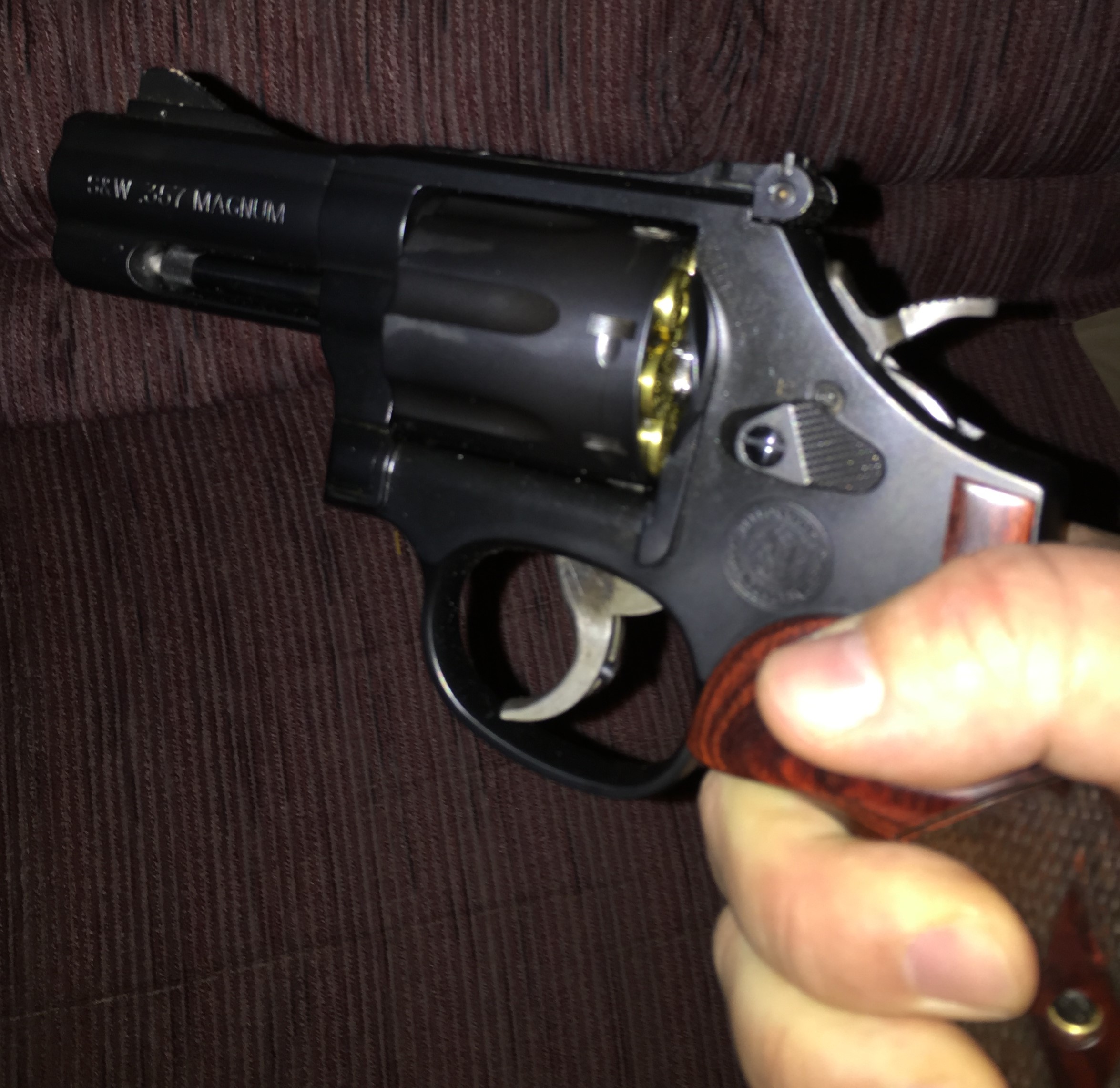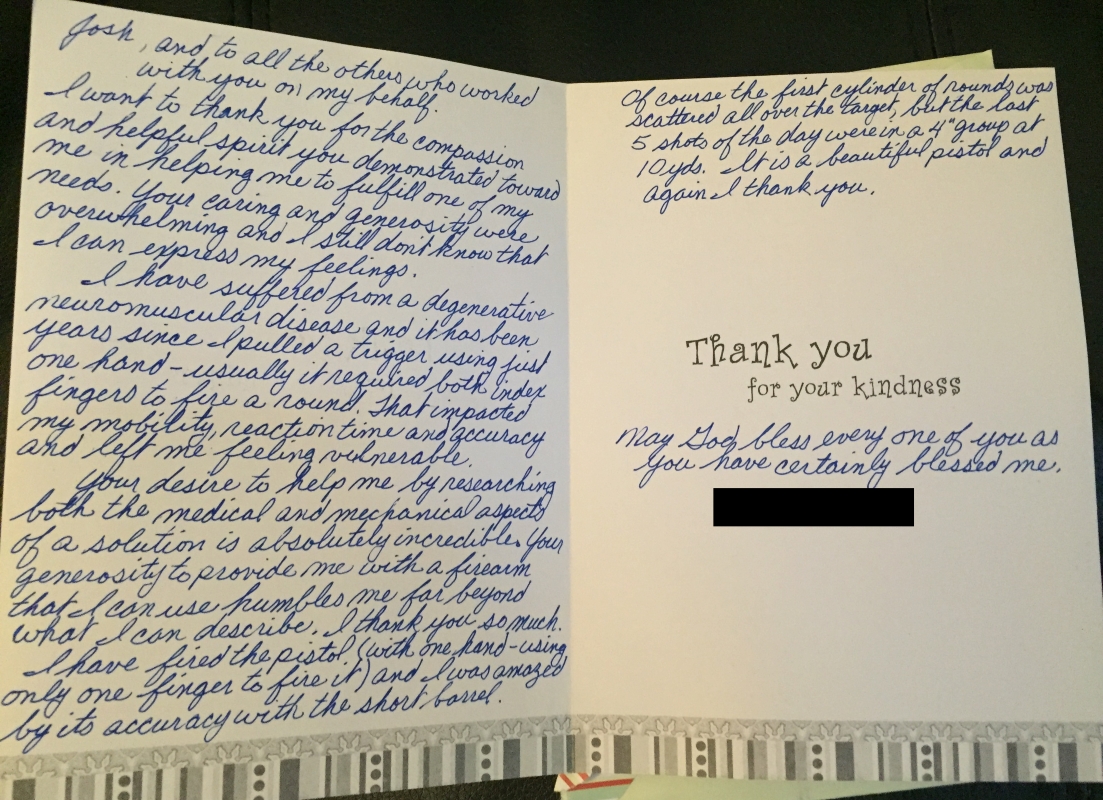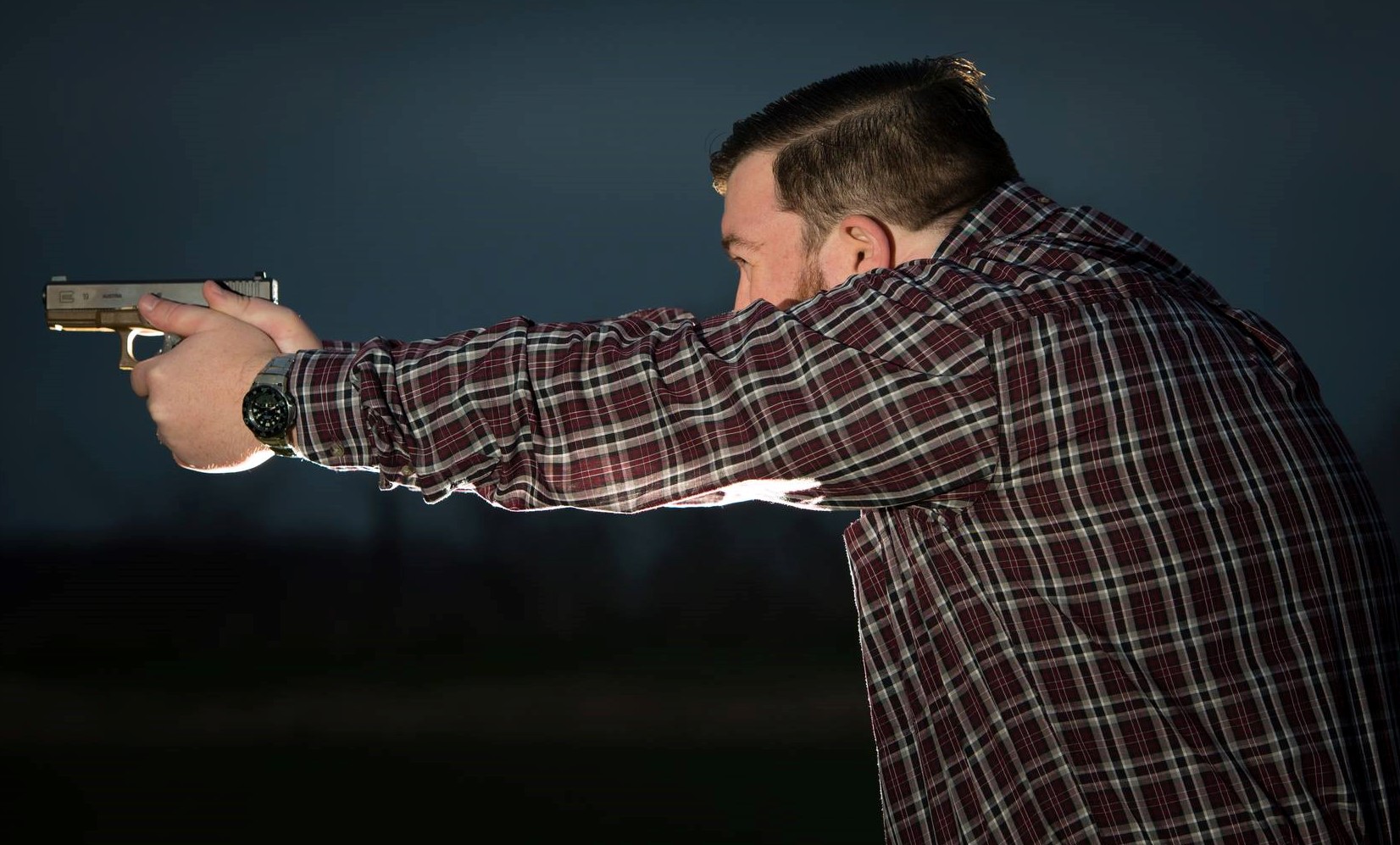
Even with shaky hands from Parkinson’s, by driving the gun out to full extension, the shooter gets a better kinesthetic alignment. This limits the shaking in his shooting hand. Photo: author
A family friend recently asked if I could help him with a shooting issue he was having. I had known for quite a while that his health had been poor and he had been in and out of the hospital. Though I didn’t know the details, I could tell this was something that had really been bothering him and that he was reaching out to me as a last resort.
He explained that for the past few years he had been suffering from a degenerative neuromuscular disease. As it had progressed, it had all but prevented him from being able to fire his defensive firearm. He was unable to pull the trigger without using two fingers (and even that was a struggle). Even loading magazines was too difficult. This new disability had left him feeling helpless and dependent on others for his and his family’s safety.
Disabled Shooting Challenges
Thinking about his situation, I imagined how I would feel if I were in his shoes. This man is a Vietnam veteran who has been a responsible firearms owner all his life, has trained and practiced his skills so he could protect his family from those who might want to harm them. Now he is faced with a disease that’s preventing him from doing all that.
I felt the need to help him but didn’t know where to begin. I told him to give me a few days and left him with this: “I won’t give up on you if you don’t give up on yourself.”
I immediately contacted a former student who is an orthopedic surgeon at a medical center in southern Indiana. He generously gave me some time out of his busy schedule to run through an in-depth explanation of the issues with this particular type of degenerative neuromuscular disease. After a little more research and information gathering, it was determined that my friend’s finger and hand muscles are fatiguing rapidly and preventing him from pulling the long, heavy trigger on his existing firearm.

Sometimes trigger work by a professional gunsmith is required to make a firearm work for you.
Photo: author
Mechanical Solutions
I spoke to a few gunsmiths and found that the particular handgun my friend was using has a trigger that progressively stacked weight until the gun went bang. This particular gun reached a little over 12 pounds before it fired. Unfortunately, there are no viable aftermarket triggers for this gun, so I began researching other possible solutions.
I realized if the trigger was stacked heavier on the front end and lighter after that, it might allow his finger to avoid fatigue during the trigger stroke. After speaking to a few people about the range of adjustability in different guns, it was clear that a revolver was going to be the best solution for this situation. Not only would it solve the trigger issue, it also solved his problem of not being able to reload his own magazines.
My super-talented gunsmith, Jordan Jackson at Black Bullet Firearms, was able to do exactly what needed to be done with an S&W Model 442 revolver he had available. He did an excellent job on the gun and smoothed it out to where it stacked at the beginning and lightened up at the end. Due to donations from some very generous friends and family, we were able to gift the gun to this gentleman, ship it to his local FFL, and pay for the transfer.
When I returned from the NRA Annual Meetings, this card had been delivered to me. It says:
Training Solutions
Friends, I am afraid many defensive firearms instructors have failed our elderly and disabled comrades. These potential students are not going to take a class where they have to complete an archaic FBI qualification course that requires people to shoot from kneeling at 25 yards. Many of these people would be hard-pressed to get to a kneeling position. And if they got there, getting up would be a real issue.
As instructors, it is our job to prepare them for self-defense within the constraints of their abilities. Not everyone needs to be trained to the standard of our FBI Special Agents. We don’t need to be putting shot timers on Grandma and telling her she has to kneel and shoot at implausible distances in 15 seconds. Does she fail if she does it in 16 seconds? That’s just absurd!
It is now abundantly clear to me that we are failing a large portion of our demographic. The baby boomers are getting older. Men and women are coming back from a decade of war. We have an obesity epidemic affecting a large percentage of our population. Do those people not deserve to be taught to defend themselves to the best of their abilities? Think about it. The self-defense industry as a whole seems to target 20- to 40-year olds, able to go rolling in the mud and complete FBI level tactical training.
Disabled shooting is not an oxymoron. If you are one of the many among that group of people—like me, who has the knees and back of an 80-year-old at the age of 37—you are not alone. You don’t have to feel vulnerable. Reach out to instructors who get it!
If I can help you, please feel free to e-mail me at jgideon@nosofttargets.com. Just because you’re not in peak physical condition doesn’t mean you have to be helpless. You can also find qualified instructors who want to help right here on the Personal Defense Network.


for fellow disabled shooters I have found a great one magazine loader that does not require a great amount of effort or strength ,easy to use one handed. . it is made by gun Nutz and is the BLT bullet loading tray easy to use one handed and highly recommend it!!
Top shelf article. Having 73 years behind me I get it! Thanks
I'm nearly 72, but didn't develop an interest in firearms until three years ago. I wanted to carry concealed but quickly learned that practicing would be difficult. First, an old and unresolved cervical disc injury weakened my support hand, so racking the slide is a challenge. Second, I now have hand tremors, so shooting accurately beyond five yards seems impossible (though I will take the author's advice). I hope more range owners and instructors will see the need (and opportunity) that exists.
I too am a disabled veteran and experience the same issues (different health conditions); but my son, an avid firearms enthusiast has been recommending me to get a revolver too. Would love to discuss further for getting help. Thanks so nuch for your kindness to that brother in arms!!
I want to get back into shooting sports, but, after about a minute of standing, my legs start shaking. Obviously can’t hold a pistol and a cane in the same hand simultaneously. Any suggestions?
I love this article because I too, am receding in health and strength. I especially love that the weapon chosen was the Airweight 442, because that's what I carry!
Would like recoup my shooting skills. Still am disabled but managing. Trying to convince that retraining is possible. Bob
You brought my awareness out. Thank you
Hello. I am a disabled vet with a very very bad right hip. Extremely weak. I am right handed. Shot the M16A2 in the Army. New to hand guns. I got a Ruger LCP MAX 380. I want to know if you could give me advice on which of the five or so main standing shooting positions would be best...where my bad hip is on the same side of my body as my dominant hand. I read about placing my left leg a half step forward, and both feet about shoulder space apart. I am not sure. If you can't help, perhaps send me a link? PS there is actually a lot of recoil to this. I naturally put more weight on my left leg/hip to take pressure off my right leg/hip. So...balance is an issue as well. Thank you.
To be honest, I haven't read all the 130+ entries, but I do have a suggestion that appears to have been overlooked: Occupational therapist's evaluation and management. These professionals' job description is evaluating one's unique disabilities, then prescribing tools and training to accomplish whatever physical goals one wants, within the limits of what's possible. Of course, the therapist must be sympathetic to firearms use, but most, regardless of how they feel, will make good analyses and give good advice. This sore of problem is right in the OT's wheelhouse.